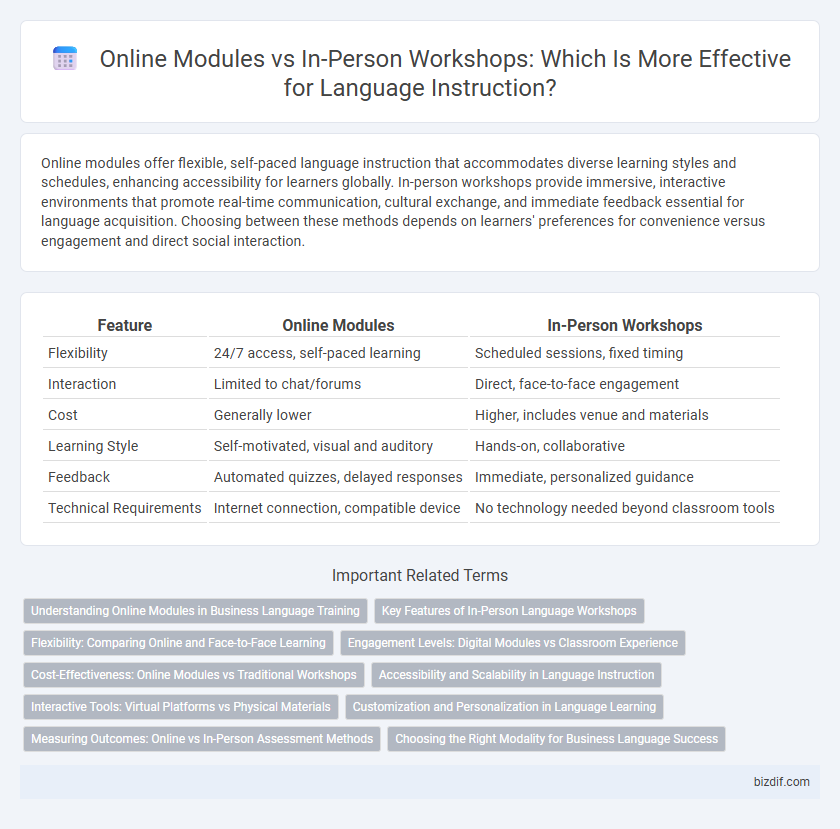Online modules offer flexible, self-paced language instruction that accommodates diverse learning styles and schedules, enhancing accessibility for learners globally. In-person workshops provide immersive, interactive environments that promote real-time communication, cultural exchange, and immediate feedback essential for language acquisition. Choosing between these methods depends on learners' preferences for convenience versus engagement and direct social interaction.
Table of Comparison
| Feature | Online Modules | In-Person Workshops |
|---|---|---|
| Flexibility | 24/7 access, self-paced learning | Scheduled sessions, fixed timing |
| Interaction | Limited to chat/forums | Direct, face-to-face engagement |
| Cost | Generally lower | Higher, includes venue and materials |
| Learning Style | Self-motivated, visual and auditory | Hands-on, collaborative |
| Feedback | Automated quizzes, delayed responses | Immediate, personalized guidance |
| Technical Requirements | Internet connection, compatible device | No technology needed beyond classroom tools |
Understanding Online Modules in Business Language Training
Online modules in business language training offer flexible, self-paced learning tailored to professionals' schedules and industry-specific vocabulary. These digital courses utilize interactive tools, such as quizzes and video scenarios, to enhance comprehension and retention of business jargon. Unlike in-person workshops, online modules enable consistent access to updated content and facilitate tracking individual progress in real-time.
Key Features of In-Person Language Workshops
In-person language workshops offer immersive, interactive learning environments that enhance pronunciation and conversational skills through real-time feedback from native-speaking instructors. These workshops promote social engagement and cultural immersion, fostering peer collaboration and immediate clarification of doubts. Small group settings and structured activities further support personalized attention and practical language usage.
Flexibility: Comparing Online and Face-to-Face Learning
Online language instruction modules offer unparalleled flexibility, allowing learners to access content anytime and tailor their study pace to individual schedules. In-person workshops provide structured sessions with real-time interaction, fostering immediate feedback and collaborative practice but often require fixed attendance times. Balancing personal time management with interactive learning environments is essential for optimizing language acquisition outcomes.
Engagement Levels: Digital Modules vs Classroom Experience
Online modules offer flexible, self-paced learning but often face challenges in sustaining high engagement levels compared to in-person workshops. Classroom experiences foster real-time interaction, immediate feedback, and collaborative activities that significantly boost learner motivation and retention. Studies indicate that active participation and social dynamics in face-to-face settings lead to deeper cognitive engagement than digital modules alone.
Cost-Effectiveness: Online Modules vs Traditional Workshops
Online language instruction modules significantly reduce costs by eliminating travel, accommodation, and facility rental expenses associated with traditional workshops. These modules often offer flexible subscription models, allowing learners to pay only for the content they need, enhancing overall affordability. In contrast, in-person workshops involve higher fixed costs, such as instructor fees and venue charges, which can limit accessibility for budget-conscious learners.
Accessibility and Scalability in Language Instruction
Online modules offer unparalleled accessibility for language learners worldwide, enabling flexible access to course materials anytime and anywhere, which significantly overcomes geographical and scheduling barriers. In contrast, in-person workshops provide direct interaction and immediate feedback but are limited by location and participant capacity, restricting scalability. Scalability of online modules allows institutions to efficiently accommodate a larger number of learners while maintaining consistent instructional quality across diverse language proficiency levels.
Interactive Tools: Virtual Platforms vs Physical Materials
Online modules leverage virtual platforms equipped with interactive tools such as real-time quizzes, gamified simulations, and collaborative whiteboards that enhance learner engagement and immediate feedback. In-person workshops rely on physical materials like handouts, flipcharts, and tangible props that facilitate hands-on interaction and direct instructor guidance. Virtual platforms provide scalable, flexible learning environments while physical materials deliver tactile experiences crucial for kinesthetic learners.
Customization and Personalization in Language Learning
Online modules offer extensive customization through adaptive algorithms that tailor lessons to individual proficiency levels and learning paces, enhancing personalized language acquisition. In-person workshops provide direct interaction with instructors who can immediately adjust teaching methods based on learner feedback and non-verbal cues, fostering deeper engagement and real-time personalization. Combining both approaches optimizes language learning by blending scalable customization with responsive, personalized instruction.
Measuring Outcomes: Online vs In-Person Assessment Methods
Online modules utilize digital analytics and automated testing to measure language proficiency through instant feedback and adaptive assessments, enhancing personalized learning outcomes. In-person workshops rely on direct observation, oral examinations, and real-time interaction to assess communicative competence and practical language skills. Both methods provide valuable data, but online assessments offer scalable, data-driven insights, while in-person evaluations capture nuanced learner engagement and contextual language use.
Choosing the Right Modality for Business Language Success
Selecting the appropriate modality for business language success depends on flexibility, interaction level, and learning pace. Online modules offer self-paced learning with interactive multimedia tools, ideal for busy professionals seeking convenience and accessibility. In-person workshops provide immersive environments and real-time practice, fostering immediate feedback and stronger interpersonal communication skills critical for business fluency.
Online Modules vs In-Person Workshops Infographic

 bizdif.com
bizdif.com